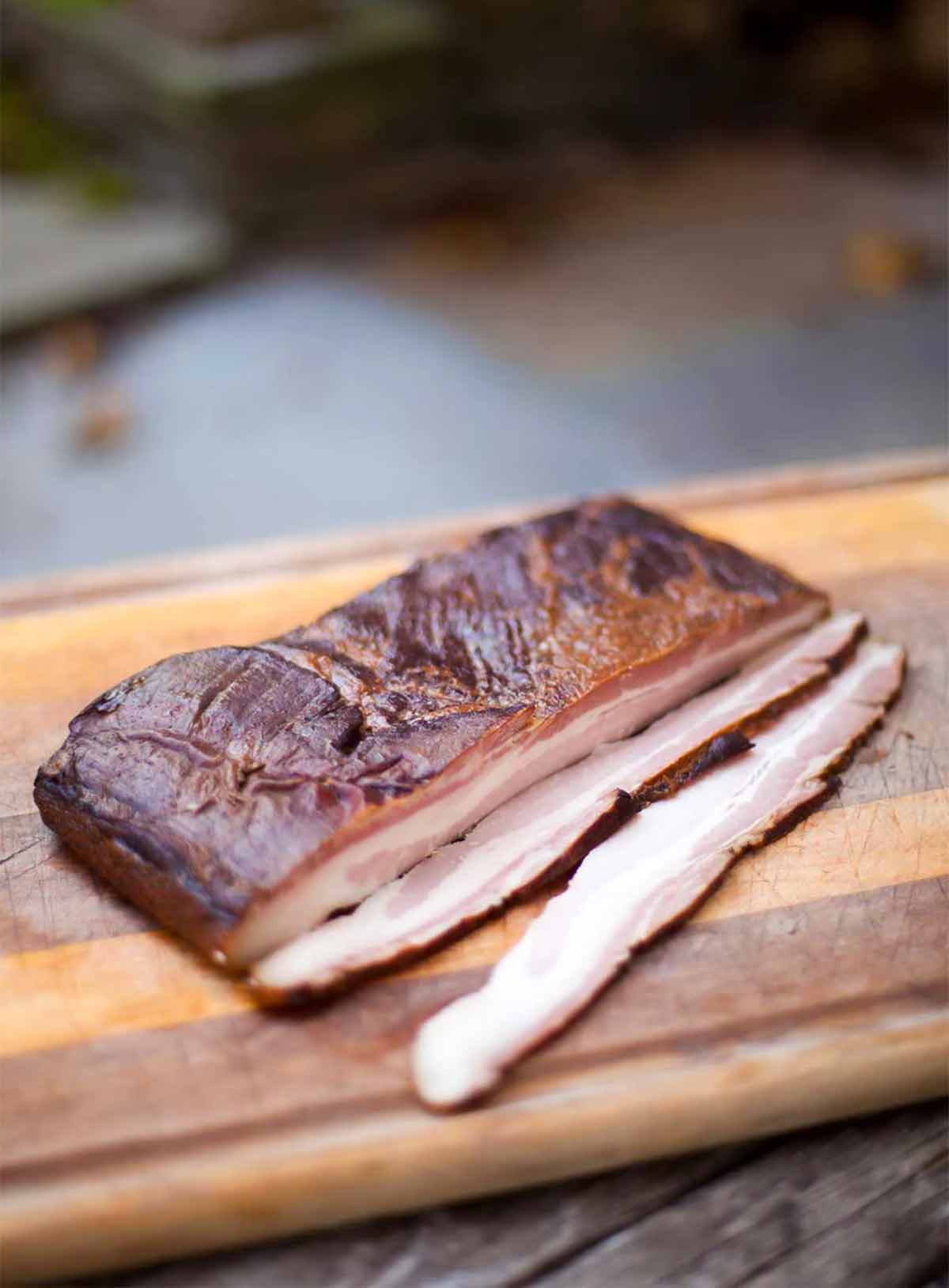
Honestly, I’m at a loss for words–hard for me, the kid who was nicknamed “Chatty Cathy” through all 12 years of school.
How can I begin to tell you how phenomenally easy it is to make your own homemade bacon? Or how incalculably better it is than that flaccid, wet, store-bought mush they have the nerve to manufacture and market?
Homemade bacon is as different from Oscar Mayer as Grace Kelly is from Kim Kardashian. There’s true smoked flavor, and in this particular recipe, there are sweet maple high notes and a hint of earthiness from the espresso.
And the texture. Homemade bacon has an exquisite chew–even thin slices. That means you don’t have to cut a honking 1/4-inch-thick piece just to sink your teeth into it. Of course, if you’re a Baconite—a true bacon lover—you know there’s no end to what you can do with it.
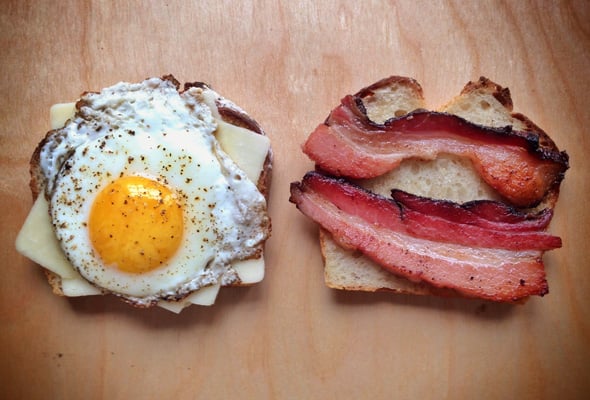
Like bacon and egg sandwiches (above), my breakfast every morning for a week. And there are the baked goods–bacon and Parmigiano-Reggiano bread, anyone?–the stews, soups, casseroles, desserts, candies. The list never ends. And every day, Baconites all over the world come up with more and more ways to use this food of the gods.
But without a doubt, one of my favorite ways to use homemade bacon, since it has the right amount of firm meat, is for lardons–those marvelous little creatures that can be sprinkled on salads, tossed in coq au vin, folded into doughs, or eaten out of hand.
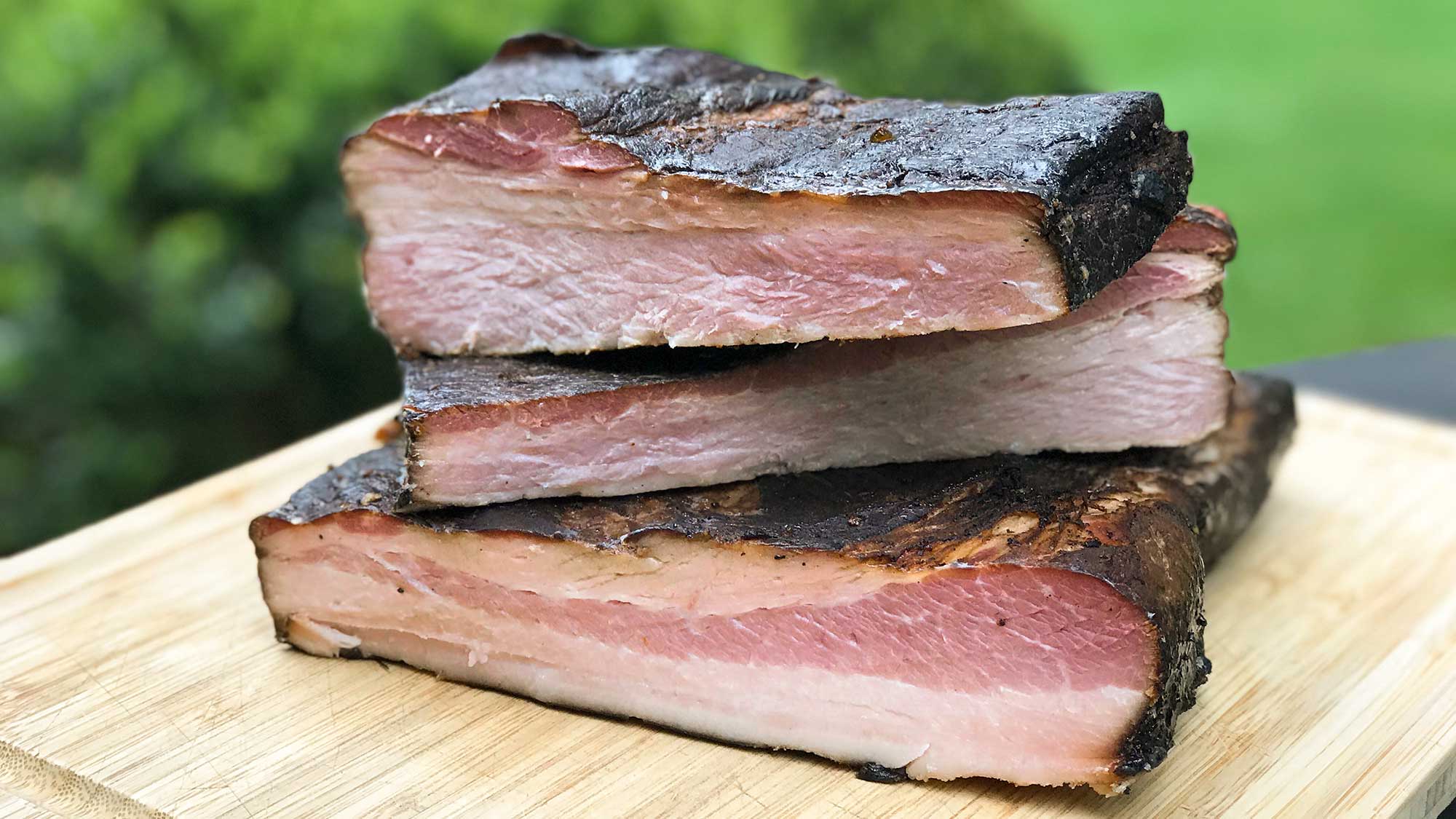
If there is one thing I want you to take away from this post—the one lesson that Fatty Daddy can give you is this—YOU CAN MAKE BACON AT HOME. You must make bacon at home. It’s an imperative—that is, if you love bacon.
Sure, you need some sort of smoker, but your tiny rusty Weber grill that you wheel out into the middle of the driveway every weekend will work. Trust me. Now go forth and start makin’ bacon.

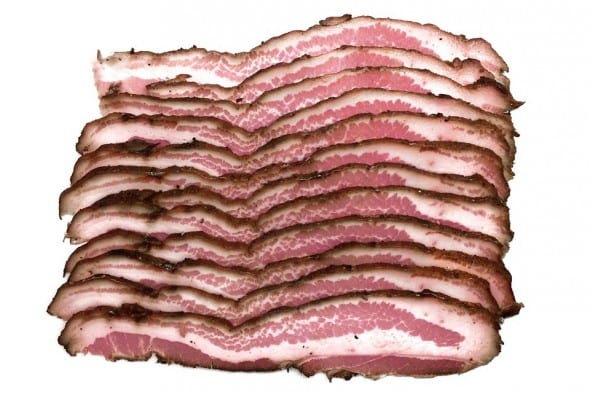
Homemade Maple-Espresso Bacon
Want to save this?
You’ve heard this a million times, but it’s crucial to find a great butcher, one you can talk to and explain all the odd things you’re doing and how he or she can help. Once a butcher knows you’re not a dilettante but really care about what you’re cooking, you’ll have a friend for life. The new blood-stained love of my life is my butcher, Christy Buso of the Meat Center in Watertown, CT. Whenever I call, she’s never daunted, just challenged. She gave be some excellent pieces of pork belly for this recipe. The One is jealous….–David Leite
What Is pink salt?
Pink salt, is a curing salt (made of 94% plain ole salt and 6% sodium nitrite) that does a few special things to meat: It changes the flavor, preserves the bacon’s red color, prevents fats from developing rancid flavors, and—most importantly in home curing—prevents many strains of bacteria from growing. It’s sold under various brand names, such as Tinted Curing Mix or T.C.M., DQ Curing Salt, Prague Powder #1, Curing Salt #1, and Insta-Cure Salt #1. Do not buy Insta-Cure Salt #2, which is used for air-cured meats that aren’t cooked, such as pepperoni, hard salami, Genoa salami, prosciutto ham, dried farmer’s sausage, capicola, etc.

Homemade Maple-Espresso Bacon
Video
Ingredients
- 5 to 6 pounds skinless pork belly, (make sure the pork belly is trimmed to an even thickness and doesn’t taper at the ends)
- 1/4 cup dark brown sugar
- 1/4 cup maple syrup
- 1/4 cup kosher salt
- 1/4 cup instant espresso powder
- 1 teaspoon Insta-Cure Salt #1, also known as Prague Powder #1 or Curing Salt #1 NOTE: if you use more or less pork belly, please use this calculator for the correct amount of pink salt
- 1 1/2 tablespoons freshly ground black pepper
- 1/4 to 1/2 cup water
- Hickory or applewood sawdust, chips, chunks, or bisquettes
Instructions
- Rinse and pat the pork belly dry. Trim any scraggly edges so the pork belly forms a neat rectangle. Save the scraps for homemade sausage, if desired. (Who in his right mind doesn't desire sausage?)
- In a medium bowl, mix the brown sugar, maple syrup, salt, espresso powder, curing salt, pepper, and enough water to make a sludgy mess.
- Using your hands, slather the mixture all over the pork belly, turning to coat all sides. Slip the floppy belly into a large resealable plastic bag and seal it. Fit the belly, in its bag, into a baking dish and then slide the whole thing into the fridge. Refrigerate for 7 days, making sure to flip the bag and massage the liquid that accumulates in the bag into the pork belly once a day.
- After 7 days, remove the pork belly from the bag, rinse it thoroughly under cool running water, and pat it lightly dry. Set up your smoker, charcoal grill, or gas grill for hot smoking using sawdust, chips, chunks, pellets, or bisquettes.
- Smoke the meat in your smoker (or, if using a charcoal or gas grill, over indirect heat) making sure to keep the temperature at 200°F (93°C), until the internal temperature of the bacon registers 150°F (65°C), roughly 3 to 4 1/2 hours, give or take some time depending on the size of your pork belly and the exact temperature of your smoker. [If you don't have the means to smoke the pork belly, you can make the bacon by brushing the fatty side with liquid smoke and then baking it in a 200°F (93°C) oven until it reaches an internal temperature of 150°F (65°C).] Remove the bacon from the smoker and let it rest until it's cool enough to handle.
- Grab a sharp knife, slice the cooled bacon as thickly or as thinly as you please, and cook it up any way you want. I can't resist sizzling it up in a skillet. Wrap the rest tightly in plastic wrap and refrigerate for up to 1 week or freeze it for up to 2 months.

An LC Original
View More Original RecipesExplore More with AI
Nutrition
Nutrition information is automatically calculated, so should only be used as an approximation.
Recipe Testers’ Reviews
I love the looks of this smoked, mahogany-colored homemade bacon. The flavors meld quite nicely with the light smokiness and provide tantalizing nuances of sweet maple and coffee. The result was nice and tender, fabulous-looking inside and out, and a great substitute for your usual bacon in any preparation.
I can’t say that I found massaging the bacon made much difference in the final taste, though I did this and flipped the bacon every day as written. The smoking procedure took 4 1/2 hours at a temperature around the 200°F mark. The final internal temperature of my bacon was a bit higher than 150°F, closer to 160°F.
This is a true story: I gave a bit of this homemade bacon to a butcher friend of mine last Friday. Today he came up to me and hugged me. He said it was the best bacon that he had EVER had. This IS the perfect bacon. I’m completely head over heels.
When I made the bacon, I mixed the cure and was instantly taken with the aroma and told my wife that this would be a GREAT bacon. I massaged the belly a couple of times a day and flipped it religiously every morning. After 8 days, I set up my trusty, modified Brinkman smoker with hardwood lump charcoal and some applewood chunks. About 40 minutes after lighting the charcoal, I put the lid on for a few minutes and when the smoker came up to 205°F I added the cured belly and a small handful of applewood chunks. About 20 minutes into the smoking, against most conventional wisdom, I threw another small handful of applewood chunks on the coals. I kept the temperature in the smoker as close to 225°F as possible for another 3 3/4 hours.
When the internal temperature of the bacon hit 150ºF, I pulled it from the smoker and let it cool for 15 minutes. I then wrapped it tightly in plastic wrap and put it in the refrigerator. Four hours later, I took the bacon out and sliced it. I have used this bacon on pizza, with wilted greens, on a bacon and egg and ciabatta sandwich, and I must say it is AMAZING all by itself and has elevated everything I’ve made with it.
This homemade bacon was the funnest recipe to test. I’ve been wanting to make bacon forever. The bacon was simple to assemble and forget about except for the daily squishing of the bags.
I asked a local chef and friend who makes charcuterie if he had any extra Insta-Cure #1, and he was surprised as he always cures bacon with #2. But I took my 3 pork bellies, which were skinless and, frankly, on the thin side and split one in half and made identical recipes using #1 and #2 Insta-Cure. Last night I washed off the cure and set the bellies on wire cooling racks overnight. Today was the 9th day and a friend fired up his Big Green Egg for me using applewood chunks. He left for work and I settled in with a book, having no idea how long it would take. When the alarm went off 35 minutes later, I was in a bit of a panic since I had no idea how to operate the Big Green Egg and I was sure this was user error. Much to my surprise, the interior was at the correct temperature of 150°F. I let it cool.
When everyone assembled, we sliced it and fried it up. It produced all the right smells, rendered a nice amount of fat, and sizzled up perfectly. To ensure fair testing, we felt it our civic duty to really taste it and managed to eat all 3 pounds of bacon between the 4 of us.
We tasted the homemade bacon 3 ways. The first was straight-up bacon munching. All 4 of us had the same immediate reaction—the bacon wasn’t very salty. In fact, it was a bit on the sweet side. Delicious, but a bit different. There was also no measurable difference between the #1 and #2 cures in color or taste. For dinner, we made no frills BLTs. The bacon in this sandwich was a whole new level of fabulous. Even though the bacon wasn’t as crisp as one would normally find (probably due to the fact it had been hand sliced and was a bit thicker than a meat slicer would create), when I bit into it, the bacon easily pulled. The final dish was a bacon macaroni and cheese.
The sounds of ecstasy from all of us would have made a great soundtrack for a “blue movie.” In the end, we loved that this bacon wasn’t nearly as salty as regular bacon, and that the flavors of both coffee and maple syrup were distinct and individual. Now that’s my idea of good pork!
I have done my share of smoking, but this was the first time I made bacon. I’m glad I did! It had a richly porky, nicely salted, slightly peppery, pleasantly sweet taste with a lingering maple syrup flavor. It was fantastic, even when I sliced a piece fresh off the smoker! When thickly sliced and fried in a pan, it was just as tasty and became crisp on the outside while the center remained nice and chewy. The edges were deeply caramelized during the smoking from the rendered fat and sugary rub. This bacon was worth every bit of the wait time.
It really was very easy, quick in terms of hands-on time, and there wasn’t much cleanup involved. I really liked that there was a lot of meat and not as much fat as you get from bacon sold in grocery stores. When I ordered my pork belly from the butcher, I asked if he could sell me some Insta-Cure #1 curing salt. He gave me what I needed plus a bit more for 50 cents. I didn’t have espresso powder so I used finely ground darkly roasted coffee beans.
We all absolutely loved it. I absolutely could not wait to smoke this gorgeous piece of pork belly. I was lucky enough to get a nice, thick, beautifully rectangular piece of pork belly to smoke. It was exactly 6 pounds and it was a perfect rectangle, so I didn’t bother cutting it.
I used ground espresso blend from Trader Joe’s (100% Arabica), pure maple syrup, organic dark sugar cane, and for black peppercorns, pimenta do reino. The timing was exactly 3 hours, though I am sure it could take less time, depending on the thickness of the pork belly. The end result was a gorgeous piece of homemade bacon. After removing the skin, I was able to cut it into 3 slabs of bacon (2 pounds each).
Of course, we had to fry some right after it cooled off. I decided to cut nice thick slices, and the general taste was a nice, smoky, sweet taste. Perhaps because I am Portuguese, I felt it could be a tad saltier—and I’m not saying MUCH more, just a bit. Nevertheless, my girls had to add it to their salads right away!
This recipe for home-cured bacon is quite good. The maple flavor is very subtle and the coffee doesn’t come through so much as coffee, but rather as an earthy richness and depth of flavor. The cure is on the sweeter side, which, contrary to what one might think, makes the bacon more versatile. It’ll go well with your breakfast eggs and grits, but it also does nicely in Asian preparations. I used it in fried rice, and it was a perfect fit with the otherwise Chinese ingredients.
While the recipe calls for curing and smoking the pork belly without the skin on, I tried it both with the skin on and off, and preferred it with the skin removed prior to curing. The cure penetrated the meat more thoroughly, and the flavor was more vivid and consistent throughout the slab. The uncured rind can be used to make your own pork rinds and lard. The one advantage to waiting until after smoking to remove the skin is that it’s much easier to remove after smoking. Other than that, I can see no advantage to leaving it on.
☞ TESTER TIP: I didn’t have any large plastic bags on hand, so I used my vacuum sealer and cut a bag to size. The vacuum-sealed bag keeps the cure and the juices in contact with the meat, so all you need to do is flip it every couple days.
The smoking process, if you use the temperature given, will take roughly 3 hours. Start measuring the temperature much earlier, of course, as the time will vary quite a bit depending upon the thickness of your pork belly and the exact temperature of your smoker. I used applewood chunks. (I prefer chunks to chips as the chunks can produce smoke for hours, whereas chips will quickly burn up.)
This homemade bacon had a wonderful savory flavor and a texture that’s different than store-bought bacon with a crisp, not crumbly, texture and a wonderful chew. Even with the brushing of the liquid smoke, it didn’t have much, if any smoky, flavor. We can’t wait to try smoking pork belly with wood chips, so much so that my husband’s request for an early Father’s Day gift is now a smoker in order to try this again—and soon!
My pork belly weighed 5 1/4 pounds and didn’t need trimming to become a neat rectangle. I mixed the rub ingredients and they turned the color of brownie batter but with the consistency of wet sand. I had a hard time making it stick on the pork belly and ended up having to wet my fingers a little to help rub it into the meat. I put the meat in a 2-gallon resealable plastic bag and put it in the refrigerator. For the first few days I did as instructed and massaged and turned the meat once a day, but due to events I couldn’t control, we had to leave town and the meat went untouched for several days. On the eighth day, I returned to town, removed the meat, and rinsed it as instructed. More unplanned events kept me from smoking the meat as planned the next day.
Finally, 2 days later, I brushed the fatty side of the pork belly with liquid smoke and baked the meat in a 200°F oven until the thickest part of the meat registered 145°F. After cooling the bacon slightly, I sliced it into strips and found the meat difficult to slice thinly. I baked the bacon at 350°F for about 20 minutes and the results were wonderful. The homemade bacon was not too salty, as is common with bacon. After reading the other reviews for this recipe, I was afraid we would need to add salt, but it was perfect for us.
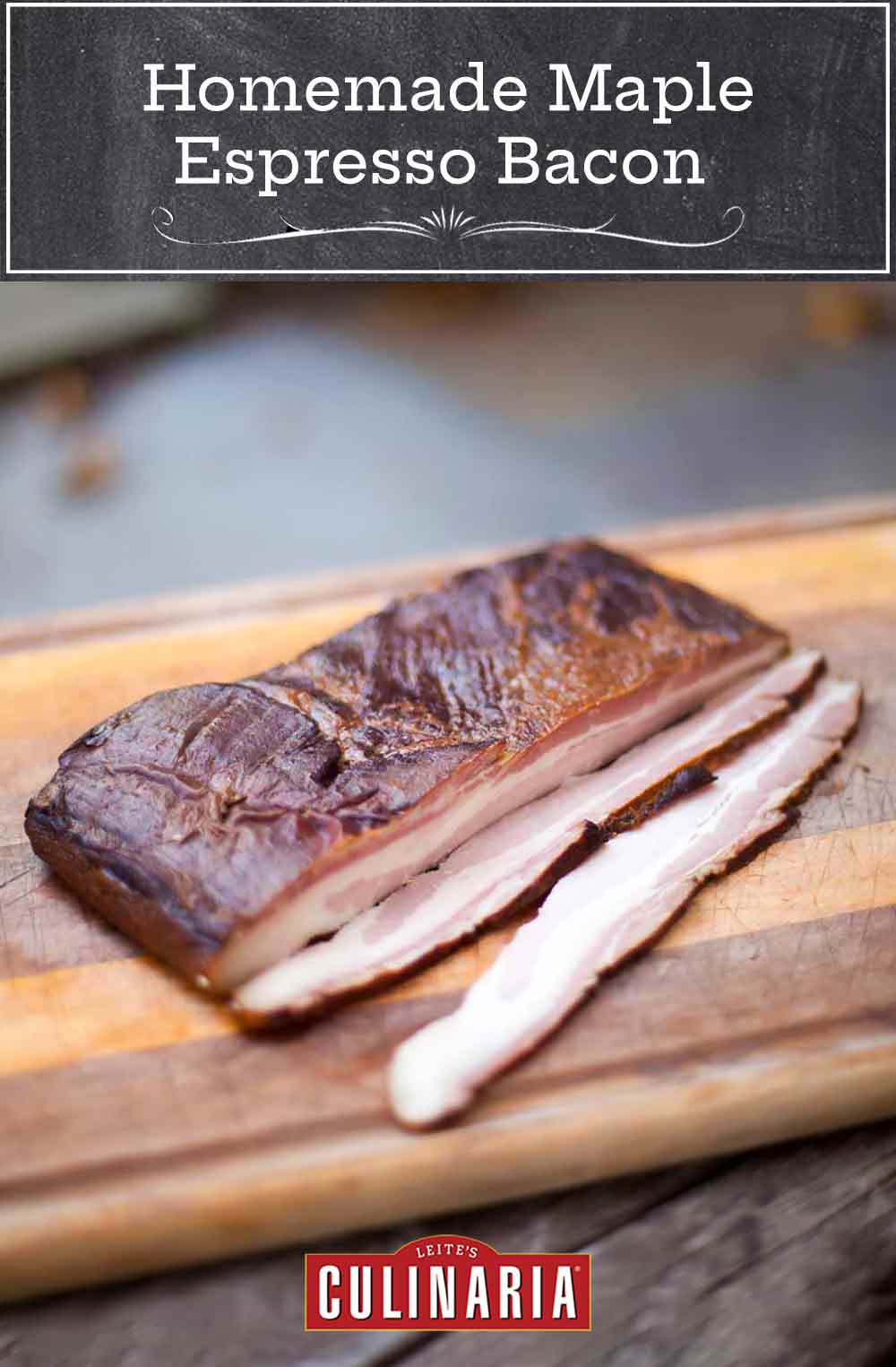

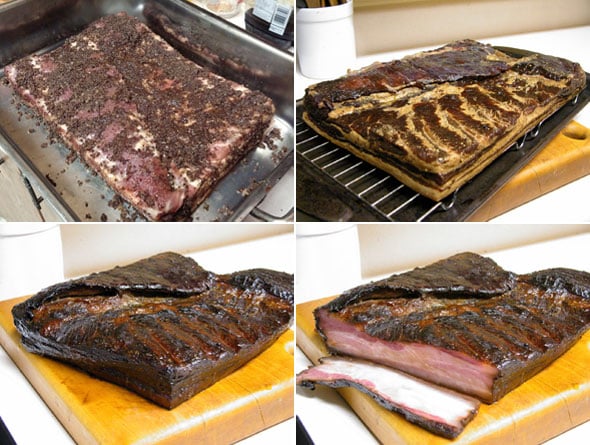















I like this recipe a lot but I’ve learned as written it’s too salty. You are using about 2.5% salt which is IMO too much. If you cut it down to 1.5-1.75% the recipe is perfect. Thank you.
Thanks for that, Jim. I’ve had no complaints, but it’s good to know it can handle using less salt. Also, what brand of salt did you use? Diamond or Morton?
Could this recipe be used for cold smoking? Are there adjustments needed other than smoking technique?
Kelli Jo, I’ve never cold smoked this, so I can say for sure. If you try it, though, let us know how it goes!
Yes you can cold smoke. I go about 6 hrs.
Thanks, Kenneth.
This recipe is really good. Will definitely use it again and give the link to others.
I’m so glad you enjoyed it, Ossie, and thanks for sharing!